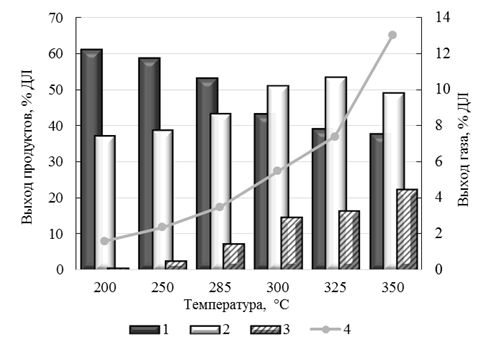THERMOCHEMICAL CONVERSION OF DIOXANLIGNIN OF WHEAT STRAW IN SUB/SUPERCRITICAL DIMETHYL CARBONATE MEDIUM
UDC 662.73 543.544.3
Abstract
The aim of this work was to study the conversion processes of dioxanlignin of wheat straw in sub/supercritical dimethyl carbonate medium. The experiment was performed in autoclave in a temperature range from 200 to 350 °С. The low-molecular-weight products were extracted from liquid fraction using hexane. GC-MS was used to analyze their composition. The solid products were analyzed by IR-spectroscopy method. The low-molecular-weight products consist of esters, aldehydes, ketones and alkyl aromatic compounds. Thirty-four compounds were identified by GC-MS, including 12 compounds С6–С3, i.e. structures which relates to acknowledged phenylpropane structure of lignin. The composition of low-molecular-weight products fraction predominantly comprised of methyl esters of aromatic and fatty acids. More than 95% of identified low-molecular-weight products are veratrous-type compounds. New data on the conversion processes of dioxanlignin of wheat straw in sub/supercritical dimethyl carbonate medium were obtained. It is shown that high solubility of dioxanlignin under subcritical conditions can be caused by cleavage of intramolecular interaction, including hydrogen bonds between macromolecules of dioxanlignin, as a result of thermal exposure and methylation reactions. Fragmentation of molecules under supercritical conditions includes the processes of a radical cleavage of alkyl aryl ester bonds as well as the reactions of dealkylation, dehydration, methylation, re-esterification and demetoxylation.
Downloads
Metrics
References
Anwar Z., Gulfraz M., Irshad M. Journal of Radiation Research and Applied Sciences, 2014, vol. 7(2), pp. 163–173. DOI: 10.1016/j.jrras.2014.02.003.
Asgher M., Ahmad Z., Iqbal H.M.N. Industrial Crops and Products, 2013, vol. 44, pp. 488–495. DOI: 10.1016/j.indcrop.2012.10.005
Perkins G., Batalha N., Kumar A., Bhaskar T., Konarova M. Renewable and Sustainable Energy Reviews, 2019, vol. 115, article 109400. DOI: 10.1016/j.rser.2019.109400.
Iqbal H.M.N., Kyazze G., Keshavarz T. BioResources, 2013, vol. 8(2), pp. 3157–3176. DOI: 10.15376/biores.8.2.3157-3176.
Yoo C.G., Meng X., Pu Y., Ragauskas A.J. Bioresour Technol., 2020, vol. 301, article 122784. DOI: 10.1016/j.biortech.2020.122784.
Gosselink R.J.A., de Jong E., Guran B., Abächerli A. Ind. Crop Prod., 2004, vol. 20, pp. 121–129. DOI: 10.1016/j.indcrop.2004.04.015.
Fache M., Boutevin B., Caillol S. ACS Sustain. Chem. Eng., 2016, vol. 4(1), pp. 35–46.
Upton B.M., Kasko A.M. Chem. Rev., 2016, vol. 116(4), pp. 2275–2306. DOI: 10.1021/acs.chemrev.5b00345.
Tsujino J., Kawamoto H., Saka S. Wood Science Technology, 2003, vol. 37, pp. 299–307. DOI: 10.1007/s00226-003-0187-3.
Kuznetsov B.N., Malyar Yu.N., Kuznetsova S.A., Grishechko L.I., Kazachenko A.S., Levdanskiy A.V., Pas-tunov A.V., Boyandin A.N., Selzard A. Zhurnal Sibirskogo federal'nogo universiteta. Khimiya, 2016, vol. 9(4), pp. 454–482. DOI: 10.17516/1998-2836-2016-9-4-454-482. (in Russ.).
Abbas K.A., Saeed M.A.E., Abdulamir A.S., Abas H.A. American Journal of Biochemistry and Biotechnology, 2008, vol. 4(4), pp. 345–353. DOI: 10.3844/ajbbsp.2008.345.353.
Khalid K.A., Ahmad A.A., Young T.L.K. Journal of the Japan Institute of Energy, 2017, vol. 96 (8), pp. 255–260. DOI: 10.3775/jie.96.255.
Fomina Ye.S., Yevstaf'yev S.N. Izvestiya vuzov. Prikladnaya khimiya i biotekhnologiya, 2018, vol. 8, no. 2, pp. 9–18, DOI: 10.21285/2227-2925-2018-8-2-9-18. (in Russ.).
Chudakov I.I. Tr. VINNSGS, 1996, no. 15, pp. 285–290. (in Russ.).
Karmanov A.P., Kocheva L.S., Ovodov Yu.S., Brovko O.S. Teoreticheskaya i prikladnaya ekologiya, 2014, no. 2, pp. 35–40. (in Russ.).
Tundo P. Pure Appl Chem., 2001, vol. 73, pp. 1117–1124. DOI: 10.1351/pac200173071117.
Tundo P., Selva M., Perosa A., Memodi S. J. Org. Chem., 2002, vol. 67, pp. 1071–1077. DOI: 10.1021/jo0057699.
Yevstaf'yev S.N., Fomina Ye.S., Tiguntseva N.P., Shashkina S.S. Izvestiya vuzov. Prikladnaya khimiya i bio-tekhnologiya, 2021, vol. 11, no. 2, pp. 195–204. DOI: 10.21285/2227-2925-2021-11-2-195-204. (in Russ.).
Ekman K.H., Lindberg J.J. Paperija Puu, 1960, vol. 42, pp. 21–22.
Marton J., Adler E. Tappi, 1963, vol. 46, pp. 92–96.

Copyright (c) 2023 chemistry of plant raw material

This work is licensed under a Creative Commons Attribution 4.0 International License.

This work is licensed under a Creative Commons Attribution 4.0 International License.
The authors, which are published in this journal, agree to the following conditions:
1. Authors retain the copyright to the work and transfer to the journal the right of the first publication along with the work, at the same time licensing it under the terms of the Creative Commons Attribution License, which allows others to distribute this work with the obligatory indication of the authorship of this work and a link to the original publication in this journal .
2. The authors retain the right to enter into separate, additional contractual agreements for the non-exclusive distribution of the version of the work published by this journal (for example, to place it in the university depository or to publish it in a book), with reference to the original publication in this journal.
3. Authors are allowed to post their work on the Internet (for example, in a university repository or on their personal website) before and during the review process of this journal, as this may lead to a productive discussion, as well as more links to this published work.











